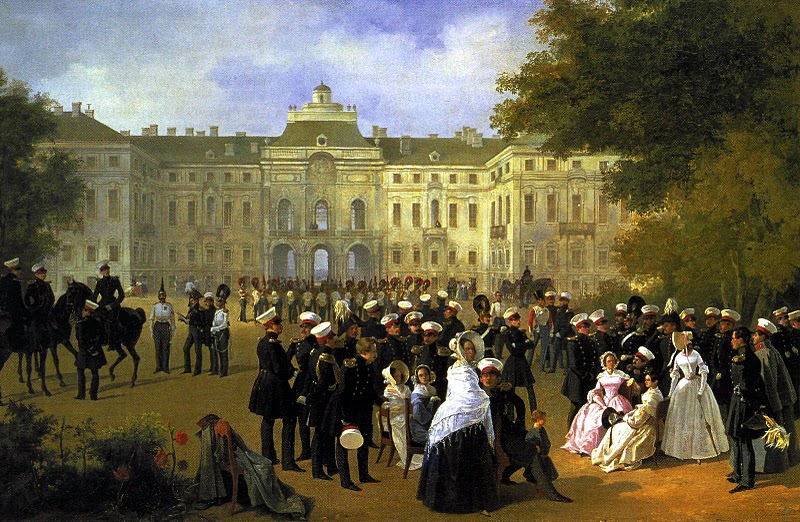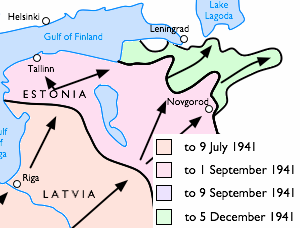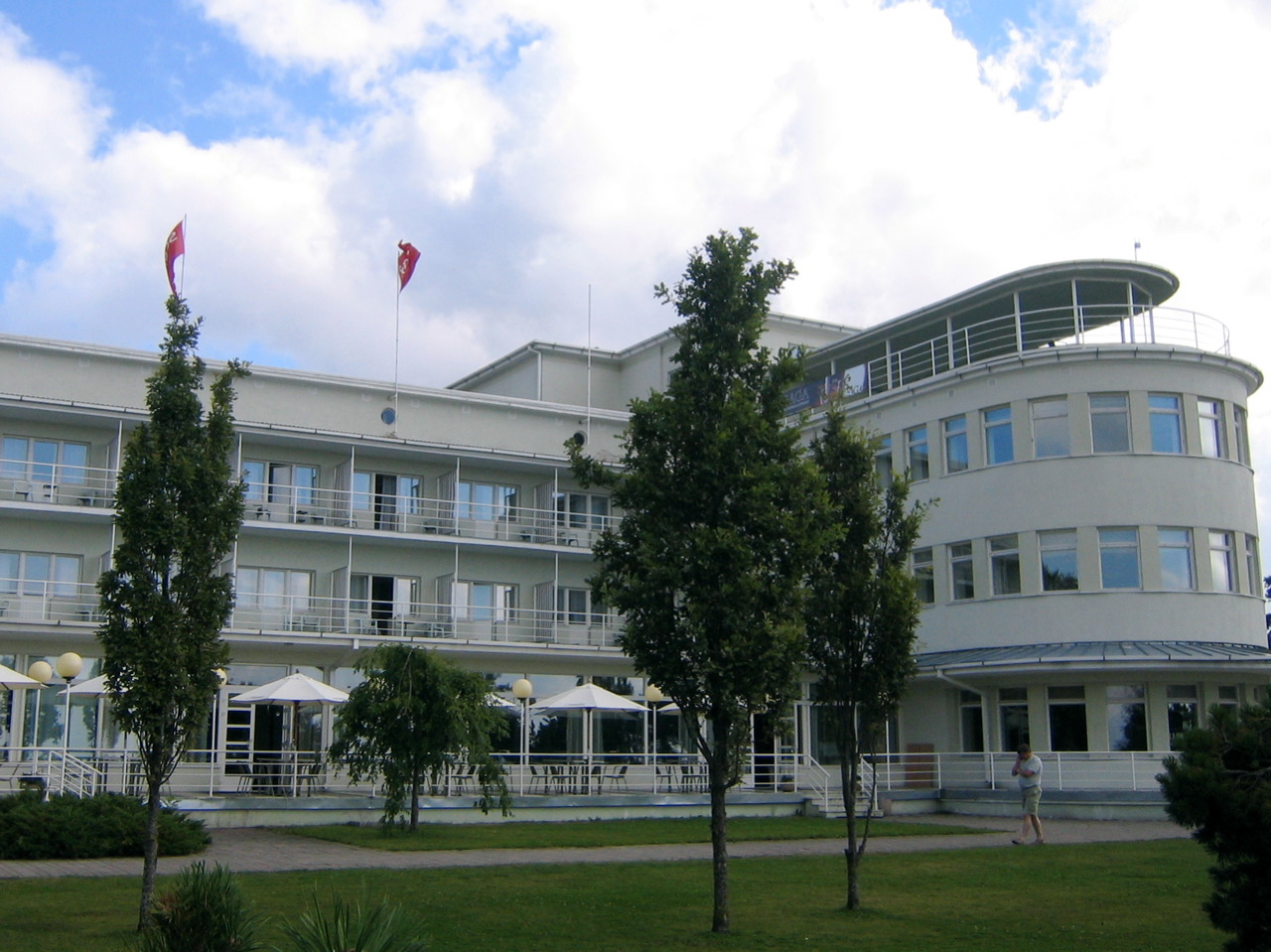|
Catherinethal
Kadriorg Palace ( et, Kadrioru loss, german: Schloss Katharinental) is an 18th-century Petrine Baroque palace in Kadriorg, Tallinn, the capital of Estonia. Both the Estonian and the German name for the palace means "Catherine's valley". It was built in 1718–1725 to Nicola Michetti's designs by Gaetano Chiaveri and Mikhail Zemtsov. The palace currently houses the Kadriorg Art Museum, a branch of the Art Museum of Estonia, displaying foreign art from the 16th to 20th centuries. The building of the Kumu branch of the museum, showing Estonian art from the 18th century onwards is located nearby in the Kadriorg Park. Construction After the successful 1710 siege of Reval (Tallinn) during the Great Northern War, Czar Peter the Great of Russia bought a small manor house at Laksberg (Lasnamäe) for his wife Catherine. Plans for a larger palace in the area were developed soon afterwards and construction of a new palace, in what is now Kadriorg, was started on 25 July 1718. The cons ... [...More Info...] [...Related Items...] OR: [Wikipedia] [Google] [Baidu] |
Mikhail Zemtsov
Mikhail Grigorievich Zemtsov (russian: Михаи́л Григо́рьевич Земцо́в; 1688 – 1743) was a Russian Empire, Russian Imperial architect who practiced a sober, restrained Petrine Baroque style, which he learned from his peer Domenico Trezzini. He has been described as "the first professionally trained Russian architect in history".James Cracraft. ''The Petrine revolution in Russian architecture''. University of Chicago Press, 1988. . Page 161. Career Peter the Great put Zemtsov in charge of implementing designs by foreign architects such as Trezzini (in whose house Zemtsov took up residence) and Niccolo Michetti (also serving as interpreter for him). In 1723 he travelled to Stockholm in order to hire the most highly skilled masons for the tsar. During the early part of his career, Zemtsov participated in designing the Summer Palace of Peter the Great, Summer Garden in St Petersburg and the park in Peterhof Palace. The other project in which he was involved wa ... [...More Info...] [...Related Items...] OR: [Wikipedia] [Google] [Baidu] |
Kadriorg
Kadriorg ( Estonian for ''" Catherine's Valley"'') is a subdistrict in the district of Kesklinn ("Midtown"), Tallinn, the capital of Estonia. It has a population of 4,561 (). The subdistrict name derives from the Catherinethal, a Baroque palace of Catherine I of Russia. It is one of the wealthiest neighbourhoods in Estonia. Kadriorg is known for the Kadriorg palace and the surrounding park, commissioned by the Russian Czar Peter the Great. Nowadays the park is a location of several museums including the Kadriorg Art Museum (a branch of the Art Museum of Estonia in Kadriorg palace), Kumu Art Museum, Mikkel, Peter the Great Museum and Eduard Vilde Museum. Nearby, close to the sea, is the Russalka Memorial which commemorates the loss of a Russian warship in 1893. The official residence of the President of Estonia is situated next to Kadriorg Palace in the park. Gallery File:Kadrioru loss 2005.jpg, Kadriorg Palace File:Presidential Palace in Tallinn, Estonia.jpg, Presiden ... [...More Info...] [...Related Items...] OR: [Wikipedia] [Google] [Baidu] |
Tallinn
Tallinn () is the most populous and capital city of Estonia. Situated on a bay in north Estonia, on the shore of the Gulf of Finland of the Baltic Sea, Tallinn has a population of 437,811 (as of 2022) and administratively lies in the Harju ''maakond'' (county). Tallinn is the main financial, industrial, and cultural centre of Estonia. It is located northwest of the country's second largest city Tartu, however only south of Helsinki, Finland, also west of Saint Petersburg, Russia, north of Riga, Latvia, and east of Stockholm, Sweden. From the 13th century until the first half of the 20th century, Tallinn was known in most of the world by variants of its other historical name Reval. Tallinn received Lübeck city rights in 1248,, however the earliest evidence of human population in the area dates back nearly 5,000 years. The medieval indigenous population of what is now Tallinn and northern Estonia was one of the last " pagan" civilisations in Europe to adopt Christianit ... [...More Info...] [...Related Items...] OR: [Wikipedia] [Google] [Baidu] |
Strelna
Strelna ( rus, Стре́льна, p=ˈstrʲelʲnə) is a municipal settlement in Petrodvortsovy District of the federal city of Saint Petersburg, Russia, about halfway between Saint Petersburg proper and Petergof, and overlooking the shore of the Gulf of Finland. Population: History Strelna was first mentioned in Cadastral surveying of Vodskaya pyatina in 1500, as the ''village of Strelna on Retse Strelne on the Sea'' in the churchyard Kipen Koporsky County. After Treaty of Stolbovo these lands were part of Sweden, and in 1630 in Strelna appears as a baronial estate of Swedish politician Johan Skytte. The estate had a marina, a water mill, a pond, a greenhouse and a small house church. Palace of Peter the Great Formerly a Swedish chancellor's estate, Strelna was chosen by Peter the Great as a place for his future summer house in 1714. Jean Baptiste Le Blond, famous for his work with André Le Nôtre at Versailles, was commissioned to prepare designs for a palace and park. ... [...More Info...] [...Related Items...] OR: [Wikipedia] [Google] [Baidu] |
German Occupation Of Estonia During World War II
During World War II, in the course of Operation Barbarossa, Nazi Germany invaded Estonia in July–December 1941, and occupied the country until 1944. Estonia had gained independence in 1918 from the then warring German and Russian Empires. However, in the wake of the August 1939 Nazi-Soviet Pact, the Stalinist Soviet Union had invaded and occupied Estonia in June 1940, and the country was formally annexed into the USSR in August 1940. Initially, in the summer of 1941, the German invaders were perceived by most Estonians as liberators from the Soviet terror, having arrived only a week after the mass deportation of tens of thousands of people from Estonia and other territories that had been occupied by USSR in 1939–1941: eastern Poland, Latvia, Lithuania, Bessarabia and Northern Bukovina. Although hopes were raised for the restoration of Estonia's independence, it was soon realized that Germans were but another occupying power. The Nazi German authorities exploited occu ... [...More Info...] [...Related Items...] OR: [Wikipedia] [Google] [Baidu] |
Alar Kotli
Alar Kotli (27 August 1904 in Väike-Maarja - 4 October 1963 in Tallinn) was an Estonian architect. He studied sculpture at the art school ''Pallas'' in Tartu during 1922-1923 and mathematics at the University of Tartu. He graduated from the University of technology in Gdańsk (then Free City of Danzig) in 1927 as an architect. Among the most famous and influential Estonian architects, Kotli has created several important landmarks in Tallinn. These include the Estonian Song Festival grounds (1957-1960, with Henno Sepmann & E. Paalmann), the main building of Tallinn University (1938-1940, with Erika Nõva), the Art Fund building (1949-1953) and the administrative building in Kadriorg park (currently the residence of the president of the Republic of Estonia) in conjunction with architect Olev Siinmaa (1937-1938). Kotli has also created many experimental apartment building projects, which were widely used after World War II when there was a serious need for new dwellings. Smalle ... [...More Info...] [...Related Items...] OR: [Wikipedia] [Google] [Baidu] |
Olev Siinmaa
Olev Siinmaa (November 12, 1881 – March 29, 1948), was an Estonian architect who is perhaps best recalled for his work in the style coined "Pärnu Resort Functionalism". Olev Siinmaa was born Oskar Siimann in Pärnu into a joinery shop owner's family. He studied interior and furniture design in Wismar and Konstanz technical schools in Germany. In 1925, he was appointed the architect of the city of Pärnu, Estonia. Siinmaa's first Functionalist design was in 1930 on Roosikrantsi Street in the Estonian capital of Tallinn. Siinmaa is possibly best recalled as the architect (along with Anton Soans) of the Pärnu Beach Hotel, constructed between 1935 and 1937. Completed in 1937, the hotel has been described as the "flagship of the new functionalist architecture." In 1938, Siinmaa, along with architect Alar Kotli competed to design the Presidential Palace, which was to be the Building of the Office of the then President of Estonia, Konstantin Päts. Kotli designed the ceremo ... [...More Info...] [...Related Items...] OR: [Wikipedia] [Google] [Baidu] |
Baroque
The Baroque (, ; ) is a style of architecture, music, dance, painting, sculpture, poetry, and other arts that flourished in Europe from the early 17th century until the 1750s. In the territories of the Spanish and Portuguese empires including the Iberian Peninsula it continued, together with new styles, until the first decade of the 19th century. It followed Renaissance art and Mannerism and preceded the Rococo (in the past often referred to as "late Baroque") and Neoclassical styles. It was encouraged by the Catholic Church as a means to counter the simplicity and austerity of Protestant architecture, art, and music, though Lutheran Baroque art developed in parts of Europe as well. The Baroque style used contrast, movement, exuberant detail, deep colour, grandeur, and surprise to achieve a sense of awe. The style began at the start of the 17th century in Rome, then spread rapidly to France, northern Italy, Spain, and Portugal, then to Austria, southern Germany, and Russia. B ... [...More Info...] [...Related Items...] OR: [Wikipedia] [Google] [Baidu] |
Konstantin Päts
Konstantin Päts (; – 18 January 1956) was an Estonian statesman and the country's president in 1938–1940. Päts was one of the most influential politicians of the independent democratic Republic of Estonia, and during the two decades prior to World War II he also served five times as the country's prime minister. Päts was one of the first Estonians to become active in politics and started an almost 40-year political rivalry with Jaan Tõnisson, first through journalism with his newspaper '' Teataja'', later through politics. Päts was sentenced to death (in absentia) during the Russian Revolution of 1905, but managed to flee the country first to Switzerland, then to Finland, where he continued his literary work. He returned to Estonia (then part of the Russian Empire), but had to spend time in prison in 1910–1911. In 1917, Päts headed the provincial government of the Autonomous Governorate of Estonia, but was forced to go underground after the Bolshevik coup in No ... [...More Info...] [...Related Items...] OR: [Wikipedia] [Google] [Baidu] |
Gustaf V Of Sweden
Gustaf V (Oscar Gustaf Adolf; 16 June 1858 – 29 October 1950) was King of Sweden from 8 December 1907 until his death in 1950. He was the eldest son of King Oscar II of Sweden and Sophia of Nassau, a half-sister of Adolphe, Grand Duke of Luxembourg. Reigning from the death of his father Oscar II in 1907 to his own death nearly 43 years later, he holds the record of being the oldest monarch of Sweden and the third-longest rule, after Magnus IV (1319–1364) and Carl XVI Gustaf (1973–present). He was also the last Swedish monarch to exercise his royal prerogatives, which largely died with him, although they were formally abolished only with the remaking of the Swedish constitution in 1974. He was the first Swedish king since the High Middle Ages not to have a coronation and so never wore the king's crown, a practice that has continued ever since. Gustaf's early reign saw the rise of parliamentary rule in Sweden although the leadup to World War I induced his dismissal of Li ... [...More Info...] [...Related Items...] OR: [Wikipedia] [Google] [Baidu] |
August Weizenberg
August Ludwig Weizenberg (6 April 1837 – 22 November 1921) was an Estonian sculptor. Weizenberg was born in the inn of Ritsike, near Kanepi, southeast Estonia. Weizenberg's father was a shoemaker and he learnt how to carve wood in Erastvere from 1858 to 1862. During the 1860s, he worked as a cabinetmaker in Frankfurt and Berlin. Thanks to a sponsorship from Friedrich Reinhold Kreutzwald, he travelled to Saint Petersburg where he was trained by Alexander von Bock. He later studied at the Imperial Academy of Arts, and from 1870 to 1873 at the Academy of Fine Arts, Munich. From 1873 to 1890, he lived in Rome. References * Jüri Hain: ''Eesti kunsti suurus ja viletsus. 150 aastat August Weizenbergi sünnist.'' In: ''Looming ''Looming'' is a term found in the study of perception, as it relates directly to psychology. Looming occurs when an object begins moving closer to the eye. As the resulting image becomes increasingly larger on the perceiver's retina, i.e., when ... ... [...More Info...] [...Related Items...] OR: [Wikipedia] [Google] [Baidu] |








